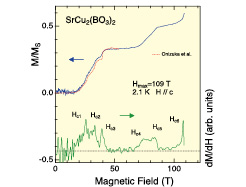Exotic spin states in SrCu2(BO3)2 at Megagauss Magnetic Fields
Y. Matsuda and Takeyama Groups
Quantum spin frustration induces interesting magnetic states in matters. A orthogonal dimer spin system SrCu2(BO3)2 exhibits fascinating phenomena due to the frustration [1]. The crystal lattice is topologically equivalent to the Shastry-Sutherland (SS) lattice. The nearest neighbor (NN) S=1/2 spins of Cu ions are antiferromagnetically coupled and form the singlet dimer through the exchange interaction J. Since the inter dimer exchange interaction J’ between the next nearest neighbor (NNN) Cu ions is antiferromagnetic as well, the orthogonal configuration makes the quantum frustration. The multiple magnetization plateaux found in high magnetic fields have attracted significant attention as the exotic phenomena. [1, 2] The distinct 1/8, 1/4, and 1/3 plateaux were observed in the magnetization process and the existence of the long predicted 1/2 plateau was reported by the magnetostriction measurement [3]. However, the whole 1/2 plateau phase was not unveiled yet because of the technical upper limit of the magnetic field 100 T. Moreover, high-field spin states in the SS lattice are theoretically suggested to exhibit the exotic states such as the supersolid state between the 1/3 and 1/2 plateaux and that above the 1/2 plateau [4]. The quantum spin state when the density of the triplet state becomes high in the SS lattice has never been uncovered yet.

Fig. 1. A magnetization curve at 2.1 K up to 109 T. Applied field is parallel to the c-axis of the crystal. The magnetic field derivative of the magnetization (dM/dH) curve is also shown as a function of magnetic field. The dotted curve is the magnetization curve reported previously. (Ref.[2])
In the present work, we have investigated the spin states of SrCu2(BO3)2 by the magnetization measurement up to 109 T using the single-turn coil method. The distinct 1/2 magnetization plateau phase has been observed in the field range from 84 to 108 T. A sharp magnetization increase at the end of the 1/2 plateau suggests the possible phase transition to the supersolid phase.
Figure 1 shows the magnetization (M) and the magnetic field derivative of the magnetization (dM/dH) as a function of magnetic field. Distinct peak structures are observed in the dM/dH curve, indicating the stepwise increase in the magnetization at critical magnetic fields (Hcn, n=1~6). By comparison with the magnetization curve in the previous report [2], Hc1~ Hc3 correspond to the boundaries of 1/8, 1/4 and 1/3 plateaux phase. The broad double-peak structure comprised of Hc4 and Hc5 may suggest that there is an exotic phase between the 1/3 and 1/2 plateau phase. Hc5 and Hc6 clarify the whole region of 1/2 plateau. The finite slope observed at the 1/2 plateau phase can be caused by the thermal excitation. The exotic spin states in the SS lattice will be clarified with a help of detailed theoretical calculations. Such collaboration work is now in progress.
References
- [1] H. Kageyama, K. Yoshimura, R. Stern, N. Mushnikov,K. Onizuka, M. Kato, K. Kosuge, C. Slichter, T. Goto, and Y. Ueda, Phys. Rev. Lett. 82, 3168 (1999).
- [2] K. Onizuka, H. Kageyama, Y. Narumi, K. Kindo, Y. Ueda, and T. Goto, J. Phys. Soc. Jpn. 69, 1016 (2000).
- [3] M. Jaime, R. Daou, S. A. Crooker, F. Weickert, A. Uchida, A. E. Feiguine, C. D. Batista, H. A.Dabkowska, and B. D. Gaulin, PNAS 109, 12404 (2012).
- [4] J. Lou, T. Suzuki, K. Harada, and N. Kawashima, arXiv:1212.1999v1 (2012).
